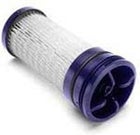A couple of things can happen to a water filter. Stored wet, for instance, and you’ll have yourself a productive little bacteria-breeding factory. And, yes, there is the sad fact that a filter will eventually reach the end of the road (or get clogged, which leaves you in the same bind). You’ll usually know this is happening when the pumping action becomes more difficult. That means junk like sand, grit, dead bugs聴that sort of thing聴has gotten into the filter and is jamming it. Chances are this will happen before you’ve pumped the 200 gallons of water that the PUR is rated to handle, as this number is also dependent on water quality and how well you take care of the thing.
 Katadyn Hiker Filter
Katadyn Hiker Filter
Some filters can be scrubbed, such as the ceramic core on MSR filters, but the PUR has to be replaced. Fortunately, that isn’t a big deal. They cost about $30 online and are a snap to install (www.purwaterfilter.com). If your filter is a few years old but just lightly used, though, I’d leave it聴they don’t “go bad” just sitting around.
The best thing you can do to ensure long filter life is to filter water that is as clean as possible. Look around for clear water if filtering from ponds or quiet streams, and keep the intake hose away from sand and silt. You want to avoid running currents, too, as moving water can stir up gunk from the riverbed. If the water looks really ugly, then fill a cookpot or other receptacle, let stuff settle down for 30 minutes, then filter it.
A few simple maintenance tricks post-hike or camp will also prolong the life of your filter: heed the manufacturer’s cleaning instructions, try the backwash approach to dislodge any crud caught within the filter itself, and sanitize with a diluted bleach solution (unless otherwise recommended) before you stash it away for the next couple of years.
Bottoms up!


